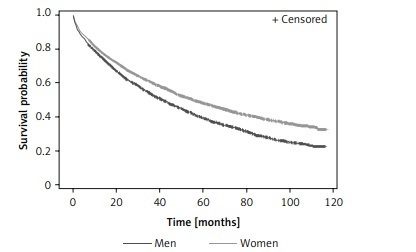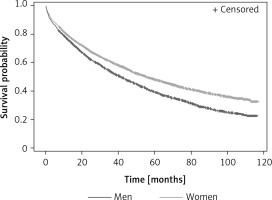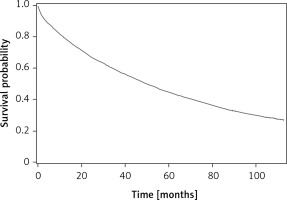Introduction
Multiple myeloma is a malignancy originating from the lymphatic system. It accounts for approximately 1% of all cancers and is the third most common blood cancer (10–15% of all blood cancers) with an incidence of 4.5–6.0/100,000 of inhabitants in Europe [1, 2]. In Poland almost all myeloma patients are treated in public healthcare units and are provided with healthcare services which, in order to be reimbursed, must be reported to the National Health Fund (NFZ). Therefore, it may be assumed that as regards this cancer type, the epidemiological data of the National Health Fund at the country level are complete [3–5].
Within the last 20 years, several treatment regimens including proteasome inhibitors and immunomodulating drugs have been introduced to the treatment of multiple myeloma. Autologous stem cell transplantation has also become more common. However, the literature lacks robust data evaluating the survival rates of patients in the Polish population or the influence of the above-mentioned significant advances in the treatment of multiple myeloma on the epidemiological parameters of multiple myeloma in Poland [3–5].
The objective of this study was to determine the incidence, prevalence, mortality and survival in patients with multiple myeloma in Poland in the period from 2008 to 2017 and to compare the actual survival rates of patients diagnosed in the years 2009 and 2013.
Material and methods
In this retrospective observational study, data reported to the NFZ by healthcare entities were used. The NFZ databases contain data on all patients having the PESEL (Universal Electronic System for Registration of the Population) – a unique identification number in Poland – whose therapy is financed from public funds. The 10th revision of the International Statistical Classification of Diseases and Health-Related Problems (ICD-10) is currently applied in Poland, and the data on each medical condition may be obtained from the NHF’s databases using the relevant code. In our statistical analysis, only patients with the diagnosis multiple myeloma (C90.0 code according to ICD-10) were considered. In the process of analysis, data were anonymised in accordance with the requirements of the Personal Data Protection Act [6]. For patient identifiers listed in this dataset, information concerning all healthcare services shown in the years 2008–2017 was downloaded. For data extraction, SQL (Structured Query Language) tools were used, with the application of the filter conformant with the diagnosis adopted in assumptions.
Incidence was defined as the number of new patients who were provided healthcare services for the first time in a given year due to the diagnosis with the C90.0 code, per 100,000 inhabitants, assuming that a new patient is a person whose identifier has not appeared in connection with the analysed ICD-10 code (C90.0) in the preceding year. Prevalence was defined as the number of patients who were provided healthcare services in a given year due to the diagnosis with the C90.0 code, per 100,000 inhabitants. Mortality was defined as the proportion of patients diagnosed with multiple myeloma who died in a given year.
Statistical analysis
One-year incidence and prevalence rates as well as 1-year, 3-year and 5-year survival rates were calculated. The estimation of overall survival (OS) was carried out using the Kaplan-Meier method; the start date of the observation was the date on which a patient with the C90.0 diagnosis appeared in the dataset for the first time, while the cut-off date was set at 31 June 2018. The OS estimation was carried out in two subpopulations shown in the period from 01.01.2008 to 31.12.2014 and from 01.01.2015 to 31.12.2017. Furthermore, the impact of sex and age on the death hazard was examined using the Cox proportional hazards model. Demographic data used to standardize the incidence and prevalence were downloaded from the website of the Central Statistical Office (CSO), for each year separately [7]. In order to carry out the statistical analysis, SAS Enterprise Guide 7.1 software, Statistica 10 and Excel were used. A p-value < 0.05 was considered to be statistically significant.
Results
The numbers of new patients with the principal diagnosis of C90.0 and patients who were provided healthcare services in particular years are presented in Table I. The percentage of male patients in this population was 46%, with the median age 66 years, mean age 65.4 (SD = 11.5; 95% CI: 65.3–65.6). The median age in female patients was 68 years, mean age 67.3 (SD = 11.2; 95% CI: 67.2–67.4).
Table I
Multiple myeloma incidence, prevalence and mortality in Poland in the years 2008–2017
The incidence of multiple myeloma increased by 30% within 9 years and accounted for 6.4 (2,427 cases) in 2009, and 8.3 (3,204 cases) in 2017 (Table I).
A significant, almost twofold increase in numbers of patients provided with health services was recorded: 4,787 in 2008 and 9,190 in 2017 (prevalence was 12.6 and 23.9 respectively) (Table I).
In successive years we also observed decreasing mortality: 0.78 in 2008 versus 0.228 in 2017 (Table I).
The prevalence to incidence ratio was increasing, being 2.14 in 2009 and 2.87 in 2017 (Table II), which, given the incidence growing in parallel, may indicate prolonged survival.
Table II
Prevalence and mortality to incidence ratios*
| Year | 2009 | 2010 | 2011 | 2012 | 2013 | 2014 | 2015 | 2016 | 2017 |
|---|---|---|---|---|---|---|---|---|---|
| P/I | 2.14 | 2.23 | 2.26 | 2.45 | 2.46 | 2.5 | 2.63 | 2.69 | 2.87 |
| M/I | 1.54 | 1.61 | 1.49 | 1.45 | 1.37 | 1.26 | 1.13 | 0.89 | 0.65 |
The mortality to incidence ratio decreased significantly, being 1.54 in 2009 and 0.65 in 2017 (Table II).
The 1-year, 3-year and 5-year survival rates in patients diagnosed with C90.0 in the years 2009 and 2013 were 70.5%, 51.5% and 40.2% versus 78.4%, 60.3% and 48.3% respectively (Table III). Additionally, the 1-year survival rate in patients diagnosed with C90.0 in 2016 was 79.2% (Table III).
Table III
Survival rate in the population of patients shown with ICD-10 C90.0 code
The number of observations used for the analysis of overall survival (OS) was 7,075 patients (3,161 men and 3,914 women) diagnosed with C90.0 for the first time in 2009. The median duration of observation was 95.9 months for men (SD = 0.755; 95% CI: 91.9–97.9) and 90.0 months for women (SD = 0.664; 95% CI: 87.2–93.6). The number of censored observations was 2,750 (38.9%), being 1,035 (32.7%) for the male population and 1,715 (43.8%) for the female population. The median overall survival (OS) for men was 41.2 months (SD = ±0.768 months; 95% Cl: 38.2–43.9). The median overall survival (OS) for women was 55.2 months (SD = 0.746; 95% CI: 51.9–59.4] (Figure 1). There was a significant difference in overall survival of men and women, with p < 0.0001. Both explanatory variables take the p < 0.0001 value. The hazard value for sex indicates that the risk of death for women was 27% lower than for men; at the same time the 1-year increase in age value resulted in a 3.9% increase in hazard (risk) of death for both sexes (Table IV). The assessment of Cox proportional hazards, with age as the explanatory variable, is presented in Figure 2.
Table IV
Result of the gender and age impact assessment in the Cox regression model
| Parameter | Degrees of freedom | Assessment of parameter | Standard error | χχ | Pr > χχ | Hazard ratio |
|---|---|---|---|---|---|---|
| Gender | 1 | –0.31501 | 0.03051 | 106.5730 | < 0.0001 | 0.730 |
| Age | 1 | 0.03827 | 0.00145 | 697.5470 | < 0.0001 | 1.039 |
Discussion
The incidence of multiple myeloma in Europe, as reported by HAEMACARE, was 5.4/100,000 inhabitants per year in the years 2000–2002, while in the U.S. registry it was 6.6/100,000 inhabitants per year in the years 2010–2014 [8, 9]. The results of our analysis are similar, with incidence of 6,4/100,000 inhabitants in 2009, and 8,3/100,000 inhabitants in 2017.
Increasing incidence results from the aging of the Polish society and better recognisability of myeloma. Weakness, anaemia, pain complaints, bone fractures, and kidney function disorders are linked with the first symptoms of multiple myeloma as the awareness of this disease increases. A significant, almost twofold increase in prevalence has been observed. The patients’ survival has improved over the years. The prevalence to incidence ratio is increasing, and the mortality to incidence ratio is decreasing, which might indicate the prolonged survival of patients.
From November 1, 2015, the so-called “Oncology Package” or “Fast Oncological Path” including support for lymphatic and haematopoietic malignancies was added to health services’ scope financed by the Polish NFZ. This could be one of the factors that might have an impact on increasing the number of new cases, although increasing awareness of myeloma as a disease, the introduction of new drugs and better supportive care appear to have the greatest impact on morbidity.
The NFZ database was created for the purpose of controlling health services financing. It contains medical claims data submitted by medical providers to the public payer. The reported assignment of the ICD C90.0 code assumes diagnosis of multiple myeloma based on International Myeloma Working Group (IMGW) criteria [10]; therefore it is unlikely that patients diagnosed with other conditions such as MGUS are miscoded as C90.0. Patients with ICD code C90.0 were recorded in the NFZ database more than once. It was not studied whether the next health service with the ICD C90.0 code was provided to the patient in the same year as the previous one or in a different year. The assumption was that if the multiple myeloma has not been confirmed, the diagnosis of C90.0 was unlikely to be repeated in the services reported to the National Health Fund, although misclassification of administrative claims data is possible in every health care system, and it can happen in every type of epidemiologic study, not only using claims data [11]. Another possible source of bias regarding disease incidence or prevalence estimates based on administrative claims data is the enrolment factor [12]. The Polish NFZ database contains only the data on services provided in the public healthcare system and lacks data from the private medical sector; however, due to the scope of services required for treatment, usually unavailable in the private sector, the percentage of such patients seems to be minimal. The above-mentioned issues might be the source of both over- and underestimating the incidence and prevalence of the disease.
The results mentioned above might have been positively affected among other things by new therapies successively being made accessible for patients thanks to reimbursement decisions (Table V). In Europe, patients gained access to bortezomib treatment in 2004. In Poland bortezomib has been available as the 2nd and 3rd line therapy for patients with refractory myeloma since 2009 and as the 1st line therapy for patients who are not eligible for autologous stem cell transplantation has been available since September 2012 (the inclusion criteria applied at that time included renal failure, age > 75 years, cytogenetic disorders) [13]. Later, in January 2015, treatment with bortezomib was made available for patients eligible for auto-SCT as induction therapy before transplant, and from 1 September 2015, any administrative limits in accessibility within labelled indications were discontinued, leading to its universal accessibility. Other new generation drugs available in Poland were thalidomide (approved in EU in 2008) and lenalidomide, available since 2009 and reimbursed under the so-called drug programme since November 2013 [13].
Table V
Major milestones in the therapeutic options for multiple myeloma in Poland
The median age of diagnosis of multiple myeloma in Poland is earlier by about 2 years compared to the data reported in the literature [14, 15]. Environmental factors and wide availability of diagnostics in Poland may play a role. Multiple myeloma has been consistently linked with agricultural exposures and rural areas [16]. Unfortunately, the study did not examine environmental factors and did not compare diagnostic methods over years.
According to currently available data, 5-year survival in multiple myeloma in the U.S. in the years 2005–2011 was 49%, compared to 27% in the years 1987–1989 [14, 15]. In our analysis, the probability of 5-year survival at the level of 50.1% was observed for patients diagnosed in 2012. The overall survival medians for NHF database patients were calculated using the Kaplan-Meier estimator [17–19].
Much worse median survival of men (41.2 months) compared to women (55.2 months) in Poland was found. Such a difference is not observed in other countries such as the U.S. [14, 15]. This difference may result from the fact that still in Poland men live about 8 years shorter than woman, mainly due to cardiovascular disorders [20–22].
The simultaneous increase in the number of patients surviving the 1st, 2nd and subsequent lines of chemotherapy necessitates the introduction of new therapies in order to let them live longer. Undoubtedly, myeloma is becoming a chronic disease; therefore, the optimization of multidisciplinary care for these patients also seems necessary [23]. This may be indicated by the low mortality to incidence ratio (M/I – see Table II), which dropped below 1 during the period studied.
In conclusions, the number of multiple myeloma patients treated in Poland in the years 2008–2017 increased continuously, which resulted from the increase in the incidence on one hand, but also from the increase in prevalence, being the effect of decreased mortality. The growing incidence may be associated with the aging of society, increased awareness of this disease among physicians, better diagnostic methods and better access to them, as well as introduction of proteasome inhibitors and immunomodulating drugs to the therapy in the period examined. The impact of making new therapies available to patients on the epidemiology of multiple myeloma requires further studies.





